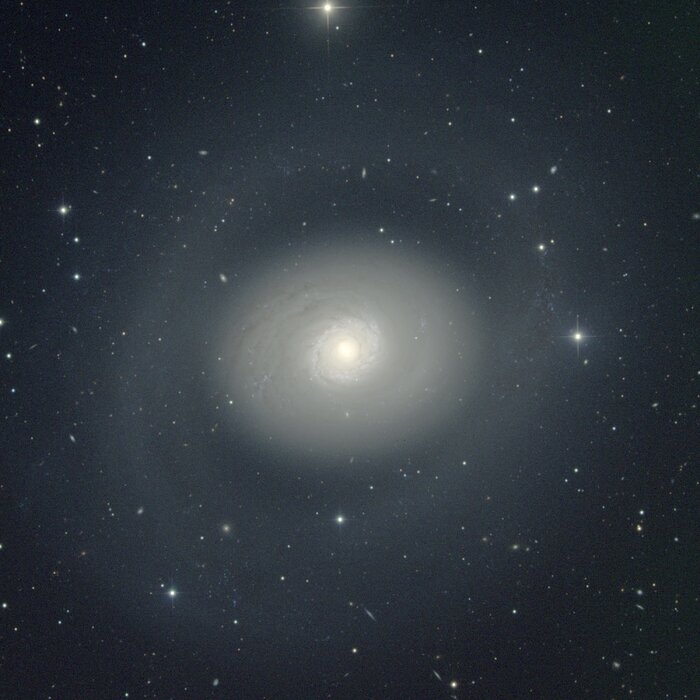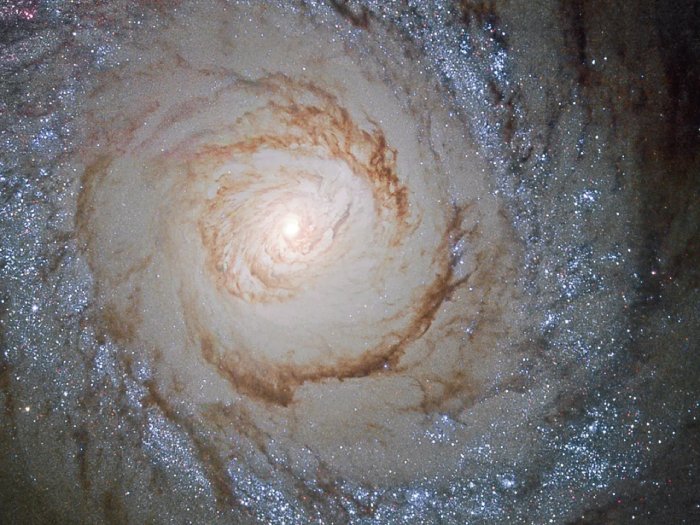M94, also known as NGC 4736 or the Cat’s Eye Galaxy, is a spiral galaxy located in the constellation Canes Venatici. Renowned for its prominent ring structure, M94 is a fascinating object of study in the realm of galactic morphology and dynamics. Positioned approximately 16 million light-years away from Earth, M94 is relatively nearby on the cosmic scale, allowing astronomers to observe its intricate features with remarkable detail. The galaxy was discovered by the French astronomer Pierre Méchain in 1781 and later cataloged by Charles Messier in his famous catalog of celestial objects.
Structure and Composition
One of the most striking features of M94 is its bright, circular ring of star formation surrounding the galaxy’s central bulge. This ring, composed of young, massive stars, is believed to have formed as a result of a gravitational interaction with a smaller companion galaxy or through the compression of gas and dust by density waves propagating through the galactic disk. The ring structure is an area of intense star formation activity, evident from the presence of numerous hot, blue stars and regions of glowing hydrogen gas. This ring gives M94 its distinctive appearance and makes it a captivating subject for both amateur and professional astronomers.
In addition to its ring structure, M94 also possesses a relatively small and compact central bulge surrounded by a diffuse disk of stars, gas, and dust. The central region of the galaxy exhibits a relatively low rate of star formation compared to the ring, suggesting that the processes governing star formation in these regions may differ. Observations of the central region have revealed the presence of a supermassive black hole at the galaxy’s core, which likely plays a role in regulating the flow of gas and influencing the dynamics of the surrounding stellar population.

Spectroscopic studies of M94 have provided valuable insights into its kinematics and chemical composition. By analyzing the light emitted by stars and gas within the galaxy, astronomers can measure the velocities of these objects and infer the distribution of mass within M94. These observations have revealed the presence of significant amounts of dark matter, a mysterious substance that does not emit, absorb, or reflect electromagnetic radiation but exerts gravitational influence on visible matter. The distribution of dark matter in M94 and its implications for galaxy formation and evolution remain active areas of research in astrophysics.
Black Hole
Studies suggest that the black hole at the centre of the galaxy has a mass millions to billions of times that of the Sun. These supermassive black holes are thought to be ubiquitous in the cores of most galaxies, including spirals like M94.
The presence of a supermassive black hole is inferred through various observational techniques. One of the most common methods involves studying the motion of stars and gas in the central region of the galaxy. The gravitational pull of the black hole causes these objects to orbit around it, and by measuring their velocities using spectroscopy, astronomers can estimate the mass of the central black hole. Additionally, observations of M94 in radio, infrared, optical, and X-ray wavelengths provide further evidence for the presence of the black hole by detecting emission from the surrounding gas and dust as it accretes onto the black hole.
The black hole in M94 likely plays a crucial role in regulating the galaxy’s evolution and dynamics. As matter falls into the black hole’s gravitational well, it forms an accretion disk—a swirling disk of gas and dust that heats up and emits intense radiation across the electromagnetic spectrum. This process, known as active galactic nucleus (AGN) activity, can have significant effects on the surrounding environment, influencing star formation rates, gas dynamics, and even the structure of the galaxy’s central regions.
In the case of M94, the activity of its central black hole may contribute to the relatively low rate of star formation observed in the galaxy’s central bulge compared to the more active star-forming ring structure. The energy released during AGN activity can heat up and disrupt the surrounding gas, inhibiting its collapse and subsequent star formation. Additionally, powerful jets of energetic particles, emitted from the vicinity of the black hole, can interact with the interstellar medium, shaping the morphology of the galaxy and affecting its evolution over cosmic timescales.
Observation
M94 has an apparent magnitude of around 8.2 to 9.0. This puts it within the range of visibility for amateur astronomers using small to moderate-sized telescopes under reasonably dark skies. However, its brightness can be affected by factors such as light pollution and atmospheric conditions. In small instruments, such as binoculars or 4 inch telescopes, it will appear as a faint fuzzy patch, rather than a detailed structure. Larger telescopes will provide better views, but smaller instruments can still offer enjoyable observations of this intriguing galaxy.
For observers in the northern hemisphere, the best time to observe the galaxy is typically from late winter to spring (February to May), when the constellation Canes Venatici is at its highest point in the sky and remains visible for longer periods during the night.




